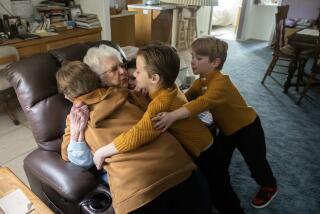Program Teaches Grandparents How to Interact Effectively With Children
- Share via
WILMINGTON, Del. — Like many people, Robert Kasey wanted to spend more time with his grandchildren after he retired in 1985. But he found he didn’t know how to be a good grandparent.
Kasey, after all, had relied on his wife to raise the children. He was the breadwinner. But he learned, and he decided others ought to learn too. So he started Creative Grandparenting Inc. in June, 1990, out of his Wilmington home.
“Creative grandparenting is an interaction between a caring older adult and a young person and both benefit,” said Kasey, 63, who has four grandchildren. “Our purpose is to educate and enable and empower grandparents to encourage the natural development of children.”
Debbie Kasey, his daughter-in-law, said Kasey took the initiative to get involved in her three daughters’ lives and she has seen a very close relationship blossom. He makes birthdays special with shopping trips, takes them for pizza and shuttles them to art lessons.
“They’re real free with him. They don’t have any inhibitions about saying what’s on their minds,” the younger Debbie Kasey said.
Kasey’s wife, Barbara, who had battled cancer for six years, died Jan. 5; the grandchildren designed the program for her memorial service.
“I think I’ll need to take care of him a little bit more since Grandma’s not with us,” 9-year-old Stephanie Kasey said. She likes going shopping with her grandfather, while her sister, Melissa, who is a year younger, said she likes him to read to her.
“I just love him, that’s all,” said Melissa.
Kasey was inspired by Arthur Kornhaber, a psychiatrist who has written books about grandparenting and believes the bond between grandparents and grandchildren is second only to that between parents and children.
The concept of creative grandparenting also provides a second chance for parents who were not overly involved with their own children, especially men, said Louise H. Sclove of New York.
“They were too busy working to be deeply involved with the children and it’s wonderfully enriching for them as well as for the (grandchildren),” said Sclove, 81, who has three grandchildren and has attended Creative Grandparenting workshops.
Kasey urges grandparents to get involved with their grandchildren or any young person and share their life experiences. He has found that both benefit when the grandparent focuses on a task with a child and gives the child undivided attention and love.
In long-distance relationships, emotional bonds can be established with audiocassettes of a grandparent reading a book, sent to the child along with the book.
Ideas such as these are shared among grandparents at workshops held by Kasey’s group. He would like to see chapters around the country, to help grandparents share ideas and problems, such as what to do in cases of divorce.
Robert Aldrich, a pediatrician in Seattle, agrees that grandparents need to be more active. He and Glenn Austin, also a pediatrician, wrote “Grandparenting for the ‘90s.”
“You can take (grandchildren) to where you work. There are all kinds of activities that grandparents know about that go on in their own lives,” he said. “They have a big network of friends. By and large, they are not a poverty group, so seeing the local sights and short trips are things they can handle.”
Kasey said his organization stresses cooperation with parents.
“We’re not in competition with the parents. We’re trying to get the parents to see that grandparents can provide a very useful role that’s very beneficial to the child and the family,” he said.
Children need emotional support and busy, working parents often are too tired to give it, said James E. Birren, director of the Anna & Harry Borun Center for Gerontological Research at UCLA.
Kasey and volunteers have developed brochures and a newsletter. A recent article in Modern Maturity magazine generated more than 2,000 letters.
More to Read
Sign up for Essential California
The most important California stories and recommendations in your inbox every morning.
You may occasionally receive promotional content from the Los Angeles Times.













